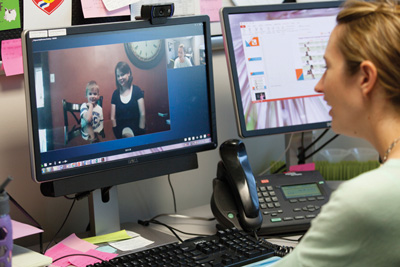A Mouthful of Peanut Butter
 Peanut butter and bananas aren’t the usual therapy tools for patients with cochlear implants. But for 4-year-old David Heady, they whet his appetite to listen. . . and speak.
Peanut butter and bananas aren’t the usual therapy tools for patients with cochlear implants. But for 4-year-old David Heady, they whet his appetite to listen. . . and speak.
Aspects Volume 39 No. 3
Written by Rebecca Budde • Photography by Jason Johnson
Caroline Montgomery holds up two bananas and David’s face lights up with a wide smile. He clearly likes bananas.
"Do you like to eat bananas plain or with peanut butter?" asks Montgomery.
While most children David’s age would respond with a quick shout, "peanut butter!" David politely articulates, "I like to eat bananas with peanut butter."
David received his first set of hearing aids at four months old; he now has two cochlear implants. Because cochlear implants don’t result in restored hearing, David has had to work hard at learning to listen and speak properly. With the help of SIU’s listening and spoken language specialist Caroline Montgomery, MSDE, children like David have a greater chance of having clear speech production and auditory speech perception, despite their hearing loss. She is the only provider within a two-hour radius of Springfield offering this unique therapy.
In Illinois, all newborns are required to have a hearing screening prior to leaving the hospital. If the infant fails the hearing test, the family doctor or pediatrician refers the family to an audiologist for further diagnostic testing. David Heady failed his hearing screening three times before his parents took him home from the hospital.
At David’s two-week check-up with his pediatrician, the Headys were referred to audiologist Brittney Reidy, AuD, who diagnosed David with severe hearing loss in both ears after his Auditory Brainstem Response (ABR) test. Though he hadn’t even spoken his first word, he received his first set of hearing aids.
 "Early detection of hearing loss and early effective treatment, with hearing aids or cochlear implants, is critical for the development of spoken language and reading skills and communication. These interventions have a profound effect on the opportunities for a hearing impaired child."
"Early detection of hearing loss and early effective treatment, with hearing aids or cochlear implants, is critical for the development of spoken language and reading skills and communication. These interventions have a profound effect on the opportunities for a hearing impaired child."
- Dr. Carol Bauer
Reidy continued to work with David through toddlerhood, adjusting his hearing aids and evaluating changes in his hearing. "Unfortunately, his hearing aids were not powerful enough to provide information to his ears that would be sufficient to hear clearly," says Carol Bauer, MD, professor and chair in the Division of Otolaryngology. "His hearing loss progressed during his first few years of life, resulting in difficulty learn ing speech and developing language skills."
Dr. Bauer then recommended cochlear implants for David. She performed surgery for David’s first cochlear implant in February 2015 at age 3; two months later, she implanted a second device in the opposite ear.
Unlike a hearing aid, which amplifies sound, a cochlear implant uses electrical signals to bypass non-functioning portions of the ear and directly stimulate the auditory nerve. This provides information that would otherwise be inaccessible to the inner ear, according to Dr. Bauer.
The cochlear implant has an external part, which looks like a hearing aid, that contains a microphone and processor that converts sound into electrical signals. The electrical signals are transmitted to the surgically implanted part of the device, and these are delivered to the inner ear through a small array of 22 electrodes. The auditory nerve sends the signals to the brain where it is recognized as sound. Hearing with a cochlear implant is very different from normal hearing, but it can give a person with hearing loss representations of sound to help make speech understandable.
The use of cochlear implants is rising with great success rates in children and adults, according to Dr. Bauer. "Children who are implanted early in life and have engaged parents who are dedicated to the aural rehabilitation hat occurs after surgery, can develop speech and language that is on par with their normal hearing peers."
The technology for hearing aids has changed dramatically, too. "Hearing aids aren’t just big microphones for the ears like they were years ago," Montgomery says. "Audiologists can program hearing aids to be customized for each person’s unique hearing loss. Today’s hearing aids can distinguish between the speech and other sounds and reduce interfering background noises."
 EARLY INTERVENTION
EARLY INTERVENTION
About three out of every 1,000 children in the United States are born with a detectable level of hearing loss in one or both ears, according to the National Institutes of Health. However, approximately 90 percent of deaf children are born to hearing parents. "These parents grew up with oral language as their main mode of communication, so that’s the mode that most will choose if they know it’s an option," Montgomery says. Neither David’s parents nor his 2-year-old brother, Noah, has hearing loss.
For children with hearing loss, quality early intervention services, appropriate technology and involved family members are key to developing normal language skills like their hearing peers. "Early detection of hearing loss and early effective treatment, with hearing aids or cochlear implants, is critical for the development of spoken language and reading skills and communication," Dr. Bauer says. "These interventions have a profound effect on the opportunities for a hearing impaired child."
Montgomery’s interventional therapy uses a modeling and imitation method, a technique developed by The Moog Center for Deaf Education in St. Louis. "Children are prompted with a question, and if there’s an error in the response, then we correct it by modeling the correct response. The expectation is that the child then repeats the sentence correctly." The modeling-imitation method helps the child practice using grammatically correct sentences as well as learn to self-monitor and self-correct," says Montgomery.
This technique develops all areas of language from articulation of sounds to the proper use of parts of speech in a complete sentence. "They really can have normal speech and language skills like their peers who don’t have hearing loss," Montgomery says. "The goal is to start therapy immediately upon diagnosis of hearing loss."
“The more he practices, the sooner he masters the language target and can use it on his own without prompting or modeling.”
- Caroline Montgomery
While state-provided services are available, both Dr. Bauer and Montgomery feel that these services don’t offer the audiological information and language development therapy that many families need. That’s where SIU specialists like Montgomery make an impact.
David’s mom, Cheryl Heady, agrees. Prior to working with Montgomery, David’s therapy was focused specifically on his speech rather than whole language development. "His therapy was not tailored to account for the needs of a deaf child," she says. "When he became too old for those services, we weren’t able to help him continue to progress with his language development on our own."
The Headys began working with Montgomery in early 2015 just before David received his implants. Prior to using the modeling and imitation method, Cheryl says that David lacked conversational skills, which could often be frustrating. "Those instances are now the exception because his expressive and receptive language has developed immensely. Caroline knows how to make learning fun," Cheryl says.
Above Photo Caption: Caroline Montgomery provides a therapy session to David Heady and mother, Cheryl, via teletherapy.LANGUAGE COACH
Unlike some other therapists, Montgomery focuses on teaching children with hearing loss how to speak rather than sign. "Many automatically think, ‘sign language’ when they hear the words ‘hearing loss’ or ‘deaf’," Montgomery says. In fact, Montgomery isn’t even fluent in sign language.
Many speech-language pathologists are not trained in working with kids with hearing loss. Many people, even in the field of deaf education are unfamiliar with listening and spoken language therapy. "It’s making new strides in the world of deafness," she explains. "It’s been around, but the outcomes are getting significantly better as more learn of its implications and as hearing aid and implant technology continues to improve."
"The main idea behind listening and spoken language therapy is that the parents are involved," Montgomery says. "Traditional speech-language pathology appointments often involve the provider working with the child while the parents sit in the waiting area." While the child is certainly present at the session, Montgomery emphasizes that the parents are her true clients.
"In a typical session, I coach the parent through an activity that targets a specific goal, like using complete sentences, and how to carry the goals over into life at home," Montgomery explains. The chosen activity is slowed down and broken down step by step. In David’s case, it’s creating a peanut butter and banana sandwich.
"There is so much wonderful language in an activity like this," Montgomery says. As the activity unfolds, David is more than happy to discuss how to make his favorite treat. "He’s talking to us about what he likes, about what he’s doing. The whole time he’s practicing these nice, long, beautiful sentences." Rather than working just once a week on improving listening and language skills, parents can continue to work with the child in a way that promotes listening and language-building skills in the home.
The activity also allows David to hit the session’s goals multiple times to reinforce his learning. "The more he practices, the sooner he masters the language target and can use it on his own without prompting or modeling."
The learning is obviously fun for David as he smears a piece of bread with peanut butter, adds the bananas, cuts the sandwich and finally takes that long-awaited bite. The lesson must be over for now though, for who can speak clearly with a mouth full of peanut butter and bananas.
TELETHERAPY
"If the parents feel more empowered, they can be better advocates and coaches for the child," Montgomery says. To further empower parents, Montgomery is using SIU Teletherapy to connect to families virtually. Montgomery and the family connect via a secure network and conduct the therapy in a similar manner to that of a clinic session.
The main difference is that the parents have to take the lead in the activity since they are physically present with the child. "Sometimes we have better outcomes this way because the parent is in control; it’s much harder for me to rescue the session," Montgomery explains.
Teletherapy offers the benefit of saving fuel and allowing families to meet at a time more convenient to their work schedule. With three little ones at home, the Headys are thankful to be able to conduct the sessions using the technology at home. "We live about 40 minutes from SIU, so being able to meet from our home is a great advantage," Cheryl says.
"Learning happens all the time, and the home is the perfect place to build listening and spoken language with the kids," Montgomery says. Sometimes, a familiar setting also allows the family to practice with language that would be more regularly used. "We have been able to do some activities at home with David, like cooking, that we couldn’t do in an office setting," Cheryl says. "Seeing Miss Caroline — in the office or on the screen — is the highlight of David’s week!"

Watch David work on his speaking
and listening with Montgomery
